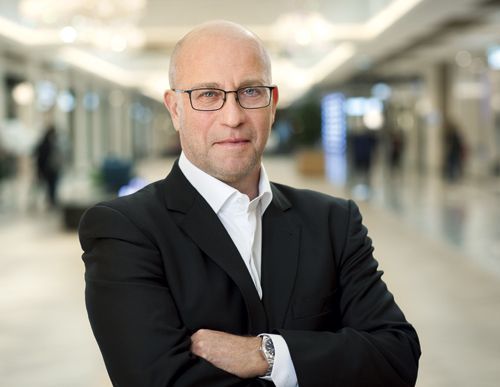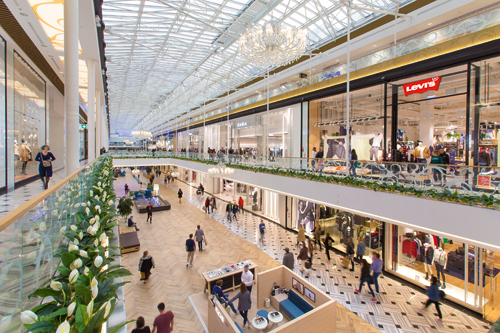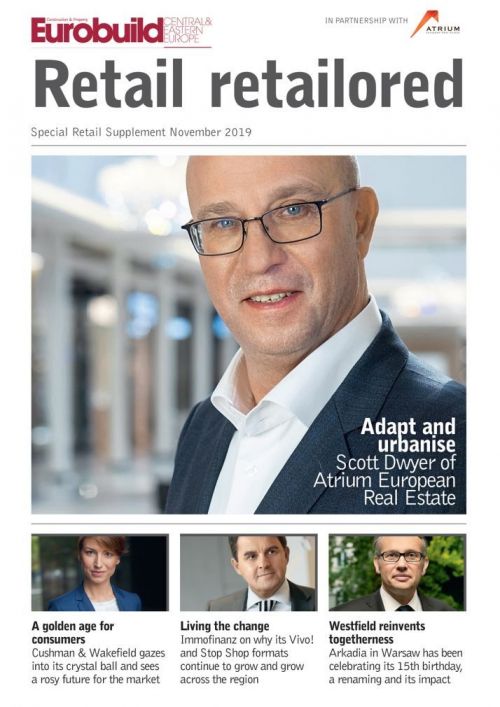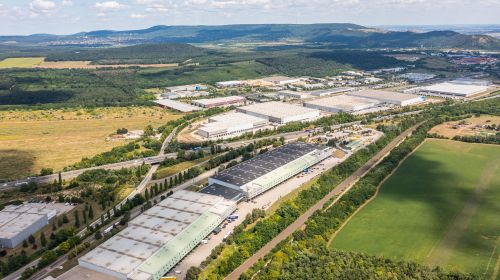Adapt and urbanise
Trends
Rafał Ostrowski, ‘Eurobuild CEE’: You’ve been doing quite a lot of refurbishments and extensions recently, to mention just your Warsaw centres Atrium Promenada, Reduta and Targówek – where the work finished last year. What prompted you to embark on these redevelopments?
Scott Dwyer, COO, Atrium European Real Estate: The real estate in our portfolio is about fifteen years old on average. So the assets needed some physical upgrading. What has changed over the last ten years is that retail concepts have become totally different when it comes to our top retailers and their size requirements. So we have to adapt to the retailers. If you don’t get ahead and move with them, they will leave your centres. Out of our top ten retailers ten years ago, 80 pct are not there any longer. So in the past our centres were about the hypermarket, the DIY and addressing consumers’ basic needs. That’s less relevant now, because people have more disposable income and their basic needs have been fulfilled. Consumers have become more aspirational. Therefore you can see the change in the tenant mix that’s happening. Hypermarkets are downsizing, DIY stores are leaving markets or consolidating, and fashion is growing. Promenada is a very good example of what I’m talking about. At Promenada we do big format fashion: big H&M, big Inditex, big TK Maxx… and they all work well together. Their sales are really strong year-on-year. Retailers also have to decide how they are allocating their capital expenditure in terms of geography and also into offline and online. So what they are doing is trying to find that balance between consolidating and rationalising their physical stores and investing money into their online operations. We want to be part of the last-mile distribution for big store retailers, so that people will come and pick up their purchases in these stores.
Being part of last-mile distribution sounds like you want to compete with warehouse developers in the city logistics segment.
Logistics people can’t do the last mile, because urban real estate is too expensive. So they have to be on the fringe of the city. It’s expensive to get to the consumer at home, and there’s also the other problem of what happens when the consumer isnʼt at home. The courier comes the next day, but thereʼs still maybe nobody home. And then what happens is that the distribution costs grow, because the courier has to come back. It’s all about efficiency for the consumer and thatʼs something we can guarantee. We have assets in dense urban locations. This is an advantage because we have convenient parking and our centres are open late, so people can pick their goods up by the front store or from a collection point in our shopping centre. And if they pick up from a store, then consumers can have a second bite at the cherry – they can try the item on, and if it doesn’t suit them they can exchange it. So we have this kind of effectiveness. And it’s also important for online retailers to have a physical presence so that they don’t disappear into the ether. They have to brand themselves for people to keep them in their minds. And part of the reason for having physical stores is so that people continue to recognise their brands, because otherwise they’d have to search for them online or somehow just always know them. But if they are present in a mall, they can advertise their brand to all the 170 mln people who pass through our shopping centres each year. Shoes and accessories retailer E-Obuwie, which has just opened one of its first physical Warsaw stores in Promenada, is doing this in a very good way. They are using it as logistics and as branding – to build loyalty and push things in that direction. So it helps us and helps them. That’s the sort of synergy we are hoping to achieve. We want to embrace it because we give them a presence, we give them the distribution, we give them points where people can come and collect whenever they need to. And that’s what we mean by taking advantage of the synergy between online and offline.
Your main shareholder Gazit Globe is an international investor with a presence in 14 countries. Do you feel that through this you are bringing global trends to Central and Eastern European retail?
I think that Central Europe and Atrium with its portfolio are in some aspects ahead of the global trends. We are setting the trends because we come from a lower base and are more flexible and eager to take up technology. The shopping centre sector here is only twenty years old. It’s 50–60 years old in other places. We are doing a lot of bold things here with real estate out of design and necessity, and we exchange ideas with our global partners to learn from each other. And we also learn a lot from them about what to do to get more local retailers into our centres. So we share this knowledge and experience with each other.
What, for example, are you able to share?
I think the experience from the large extensions we are doing. We recognised early on that we have to own and protect the sites around the shopping centres in order to be flexible as well as to redevelop. In markets that have been around longer, the surrounding land has already been bought up by other people and so assembling the sites for extensions becomes more challenging. But if you already have the land around your centre or if you set out to buy it – and we are doing that – you can expand your malls more aggressively than others, as we do.
Republic of Taste – food court in Atrium Promenada
And what experience can you take from the other markets where Gazit is present?
I think they do local retailer recruiting very well. If you look at the shopping centres around Central and Eastern Europe, they have more or less the same tenant line-up wherever you go. And what we are trying to do is to learn from their experience how to develop more local retail brands. Having a good restaurant, for example, that has a reputation in the neighbourhood. And a good coffee shop. We will take a beauty salon from somewhere locally and bring it into our centre, to have that community focus. In order to do that you need people who know the local market, who actually live there, rather than just having a centralised leasing team that rounds up the usual suspects to transact the leasing with.
What does community focus mean to you?
Community means many things. It means I get up in the morning and I go to the gym or the medical centre or for a coffee, or I meet some friends, or go otu to have breakfast, or I want to have some time off –we have to cater for all of that rather than just fashion and food. In this way we address the needs of the established community, the young people moving into cities such as Prague or Warsaw, and of older people wanting to downsize and move into smaller apartments or houses. And so they want to have options for dining out or working out and so on. This is part what we want to do, that is, having a community in a shopping centre. Also, we have community zones that we have set aside for the community to use. One of these, for example, is Fifth Dimension in Promenada, where we have a variety of classes and different types of engagement in the mornings with mothers and in the afternoon, with kids learning languages. So it’s tailor-made for people throughout the day.
You have set aside 140 sqm in Promenada for this cultural zone, where you provide free language classes, cooking and DIY workshops, and playrooms for children. Why are you doing that?
Because it is part of what the community needs. It builds a feeling of connection with the community and encourages people to say: this is my place! It builds loyalty and regular footfall for us. And I believe that as the population ages, and also as young families move into urban areas, places like this will become more and more important.
Atrium Promenada is to be expanded to 100,000 sqm by 2023
Atrium once had 170 assets. Now you are down to only 32. What prompted you to reduce your portfolio?
We have fewer assets, but our portfolio is growing in value. We want to have fewer but bigger assets in large urban centres like Warsaw and Prague. These cities are growing all the time, people are coming into them and, as they continue to urbanise, the number of people and their purchasing power grows. So the neighbourhood around Promenada should grow in terms of the number of people and their purchasing power in the next five years by around 25 pct. This is where the long term value in this real estate lies. And as more apartments around get built there, then our own real estate becomes more expensive and we can start looking at what we can do upwards.
More can be built around Promenada?
We own land that surrounds Promenada. We could do some mixed-use or add density to the existing retail real estate. We’ve assembled more than 4 ha of land around Promenada since we purchased the asset to enable us to double the size of the centre by up to 100,000 sqm by 2023. The development work taking place at the moment is infrastructure preparation for future phases.
How do you intend to ‘densify’ your real estate?
We specialise in urban locations, but it happens that such locations may no longer just be pure retail. You have to move towards more mixed-use formats. This is one of the trends we can also see in other global markets. Homes for the elderly are getting built on top of retail assets, and the same is happening with the wider residential market. And this also increases the immediate catchment area. We have parking spaces around our assets, which over time will become less and less necessary as the real estate increases in value and alternative modes of transport become more mainstream. So this is the long term planning we are doing for increasing the density of our assets in the future. If this doesn’t happen now, it could happen in another ten years. But it will happen, because on other markets that have already gone through this evolution of urbanisation, we can see it happening. We know how to do real estate and retail real estate is probably the most complex type. Adding mixed-use elements to our real estate is possible.
You also bought Wars Sawa and Junior department store complex in the centre of Warsaw last year. These three large buildings line one side of Warsaw’s main street, Marszałkowska. What will happen there?
When we bought this asset it had a very steady and long lease duration of five years, so we can’t do anything dramatic immediately. We are working with several architects at the moment to come up with some plans and we are in a dialogue with the city to make sure that our vision are coordinated with the city’s. So our role is to regentrify or upgrade this area of the city, which hasn’t had so much investment in the past. The plan is to invest in the physical aspects of the buildings and their surroundings in order to create a better place for people in Warsaw to spend time in and visit.
What style will it have? What would you compare it to?
Well, we’ve got international architects familiar with concepts from around the world, from the UK, New York and the Netherlands – from such places as Rotterdam and London, where you ideas can be taken from. We are aiming to create or backfill a downtown destination, both underground and above, with food, leisure, hotels, restaurants and retail, all in one.
I guess that will mean closing the centre completely for redevelopment.
Our plans haven’t been drawn up yet, so we still can’t articulate what we are going to do. But the architects we have engaged have got a lot of ideas and we also have a lot of ideas. It just depends on what makes sense for this asset and its surroundings. We’ve held a competition between five architects and this has yielded many ideas, although nothing has been decided on yet. But we are aiming to start the physical work in 2023.
The Atrium Promenada shopping centre in Warsaw
Aren’t you afraid of what’s happening in the US? Doesn’t the ‘retail apocalypse’ pose a real threat to your business?
You have to look at the fundamentals. What’s the density of retail here and in the US? It’s probably denser in the US than here by multiples of ten. And there was a big push towards suburbanisation there. Now people don’t want to have these suburban places anymore. They want to be more urban and in CEE markets people are urban already. And we haven’t got such a rate of new retail supply going on here. The supply in Poland used to be 6 pct per year, but now it’s down to one or two, so the kind of density in the US won’t happen here. But sales are still growing and that money has to be spent in existing centres.
You don’t see e-commerce as representing any kind of threat to your plans either?
No. E-commerce forms part of omni-channel sales. Around 80 pct of e-commerce is picked up in-store. We sell experience, we sell customer loyalty, we sell a venue that will compete in different ways with other formats, such as outlets and online, going forward. To summarise all of this, you maybe can’t see us doing much physically this year, but we are busy in the background changing our approach. And this is all about the longer term and protecting the value of our real estate, which we can do as a long term owner and occupier. Our strategy is entirely focused on urban real estate. Its mix and style will change, but it’s all about making real estate in urban areas more valuable over time – and we will be adapting our assets to make sure that this happens.






















































